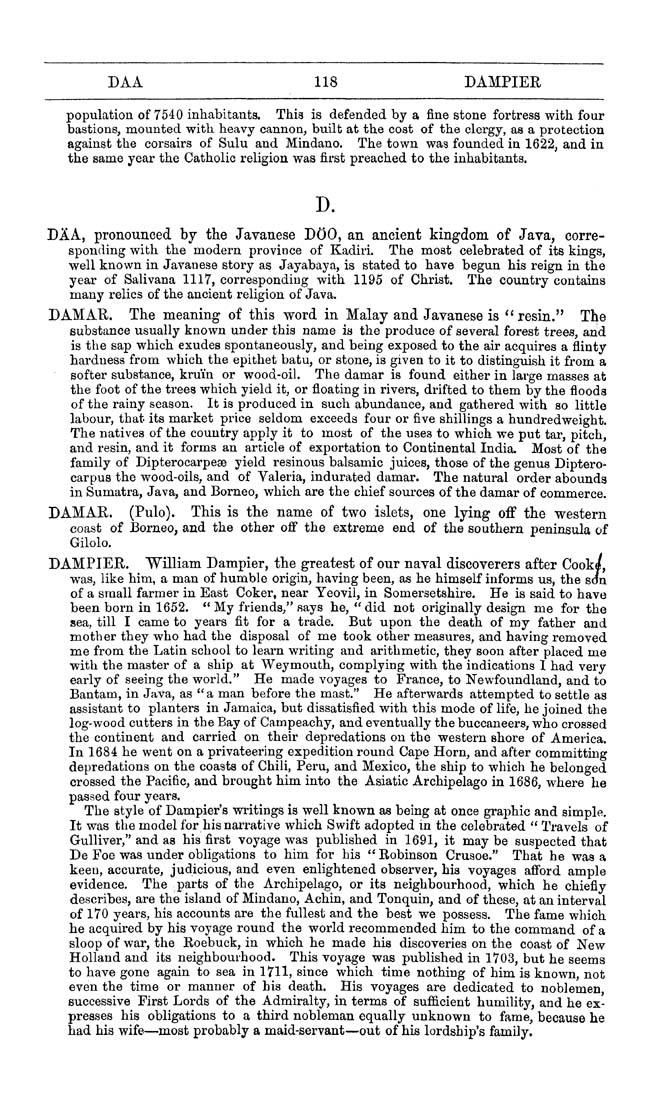DAA 118 DAMPIER
population of 7540 inhabitants. This is defended by a fine stone fortress with four
bastions, mounted with heavy cannon, built at the cost of the clergy, as a protection
against the corsairs of Sulu and Mindano. The town was founded in 1622, and in
the same year the Catholic religion was first preached to the inhabitants.
D.
DAA, pronounced by the Javanese DOO, an ancient kingdom of Java, corre¬
sponding with the modern province of Kadiri. The most celebrated of its kings,
well known in Javanese story as Jayabaya, is stated to have begun his reign in the
year of Salivana 1117, corresponding with 1195 of Christ. The country contains
many relics of the ancient religion of Java.
DAMAR. The meaning of this word in Malay and Javanese is ** resin." The
substance usually known under this name is the produce of several forest trees, and
is the sap which exudes spontaneously, and being exposed to the air acquires a flinty
hardness from which the epithet batu, or stone, is given to it to distinguish it from a
softer substance, kruin or wood-oil. The damar is found either in large masses at
the foot of the trees which yield it, or floating in rivers, drifted to them by the floods
of the rainy season. It is produced in such abundance, and gathered with so little
labour, that its market price seldom exceeds four or five shillings a hundredweight.
The natives of the country apply it to most of the uses to which we put tar, pitch,
and resin, and it forms an article of exportation to Continental India. Most of the
family of Dipterocarpese yield resinous balsamic juices, those of the genus Diptero¬
carpus the wood-oils, and of Valeria, indurated damar. The natural order abounds
in Sumatra, Java, and Borneo, which are the chief sources of the damar of commerce.
DAMAR. (Pulo). This is the name of two islets, one lying oflP the western
coast of Borneo, and the other off the extreme end of the southern peninsula of
Gilolo.
DAMPIER. William Dampier, the greatest of our naval discoverers after Cooki,
w^as, like him, a man of humble origin, having been, as he himself informs us, the sou
of a small farmer in East Coker, near Yeovil, in Somersetshire. He is said to have
been born in 1652. " My friends," says he, "did not originally design me for the
sea, till I came to years fit for a trade. But upon the death of my father and
mother they who had the disposal of me took other measures, and having removed
me from the Latin school to learn writing and arithmetic, they soon after placed me
with the master of a ship at Weymouth, complying with the indications I had very
early of seeing the world." He made voyages to France, to Newfoundland, and to
Bantam, in Java, as " a man before the mast." He afterwards attempted to settle as
assistant to planters in Jamaica, but dissatisfied with this mode of life, he joined the
log-wood cutters in the Bay of Campeachy, and eventually the buccaneers, who crossed
the continent and carried on their depredations on the western shore of America.
In 1684 he went on a privateering expedition round Cape Horn, and after committing
depredations on the coasts of Chili, Peru, and Mexico, the ship to which he belonged
crossed the Pacific, and brought him into the Asiatic Archipelago in 1686, where he
passed four years.
The style of Dampier's writings is well known as being at once graphic and simple.
It was the model for his narrative which Swift adopted m the celebrated " Travels of
Gulliver," and as his first voyage was published in 1691, it may be suspected that
De Foe was under obligations to him for his " Robinson Crusoe." That he was a
keen, accurate, judicious, and even enlightened observer, his voyages afford ample
evidence. The parts of the Archipelago, or its neighbourhood, which he chiefiy
describes, are the island of Mindano, Achin, and Tonquin, and of these, at an interval
of 170 years, his accounts are the fullest and the best we possess. The fame which
he acquired by his voyage round the world recommended him to the command of a
sloop of war, the Roebuck, in which he made his discoveries on the coast of New
Holland and its neighbourhood. This voyage was published in 1703, but he seems
to have gone again to sea in 1711, since which time nothing of him is known, not
even the time or manner of his death. His voyages are dedicated to noblemen,
successive First Lords of the Admiralty, in terms of sufficient humility, and he ex¬
presses his obligations to a third nobleman equally unknown to fame, because he
had his wife—most probably a maid-servant—out of his lordship's family.
|








